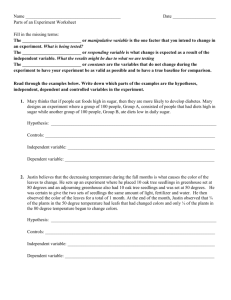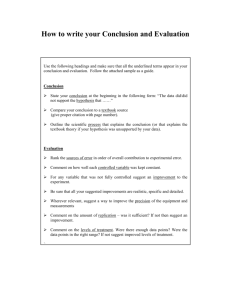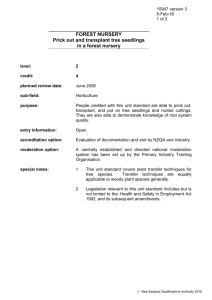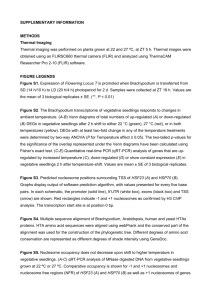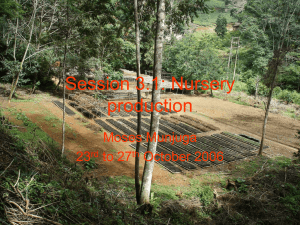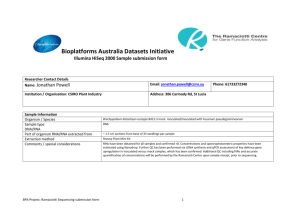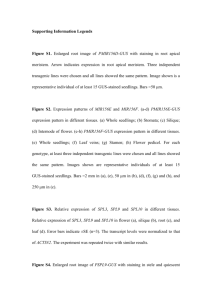Production of phytohormones in stressed and inoculated
advertisement
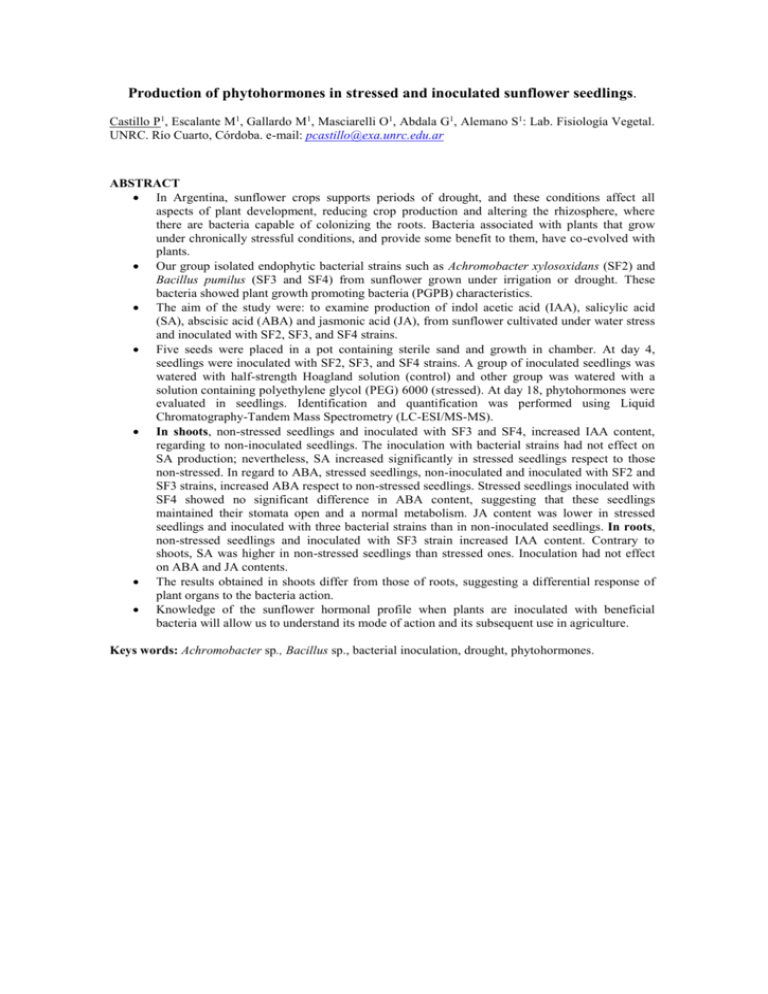
Production of phytohormones in stressed and inoculated sunflower seedlings. Castillo P1, Escalante M1, Gallardo M1, Masciarelli O1, Abdala G1, Alemano S1: Lab. Fisiología Vegetal. UNRC. Río Cuarto, Córdoba. e-mail: pcastillo@exa.unrc.edu.ar ABSTRACT In Argentina, sunflower crops supports periods of drought, and these conditions affect all aspects of plant development, reducing crop production and altering the rhizosphere, where there are bacteria capable of colonizing the roots. Bacteria associated with plants that grow under chronically stressful conditions, and provide some benefit to them, have co-evolved with plants. Our group isolated endophytic bacterial strains such as Achromobacter xylosoxidans (SF2) and Bacillus pumilus (SF3 and SF4) from sunflower grown under irrigation or drought. These bacteria showed plant growth promoting bacteria (PGPB) characteristics. The aim of the study were: to examine production of indol acetic acid (IAA), salicylic acid (SA), abscisic acid (ABA) and jasmonic acid (JA), from sunflower cultivated under water stress and inoculated with SF2, SF3, and SF4 strains. Five seeds were placed in a pot containing sterile sand and growth in chamber. At day 4, seedlings were inoculated with SF2, SF3, and SF4 strains. A group of inoculated seedlings was watered with half-strength Hoagland solution (control) and other group was watered with a solution containing polyethylene glycol (PEG) 6000 (stressed). At day 18, phytohormones were evaluated in seedlings. Identification and quantification was performed using Liquid Chromatography-Tandem Mass Spectrometry (LC-ESI/MS-MS). In shoots, non-stressed seedlings and inoculated with SF3 and SF4, increased IAA content, regarding to non-inoculated seedlings. The inoculation with bacterial strains had not effect on SA production; nevertheless, SA increased significantly in stressed seedlings respect to those non-stressed. In regard to ABA, stressed seedlings, non-inoculated and inoculated with SF2 and SF3 strains, increased ABA respect to non-stressed seedlings. Stressed seedlings inoculated with SF4 showed no significant difference in ABA content, suggesting that these seedlings maintained their stomata open and a normal metabolism. JA content was lower in stressed seedlings and inoculated with three bacterial strains than in non-inoculated seedlings. In roots, non-stressed seedlings and inoculated with SF3 strain increased IAA content. Contrary to shoots, SA was higher in non-stressed seedlings than stressed ones. Inoculation had not effect on ABA and JA contents. The results obtained in shoots differ from those of roots, suggesting a differential response of plant organs to the bacteria action. Knowledge of the sunflower hormonal profile when plants are inoculated with beneficial bacteria will allow us to understand its mode of action and its subsequent use in agriculture. Keys words: Achromobacter sp., Bacillus sp., bacterial inoculation, drought, phytohormones. INTRODUCTION Sunflower (Helianthus annuus L.) is a widely cultivated oil crop around the world. In Argentina, the potential area for sunflower planting extends from Chaco in the north to La Pampa in the south. Sunflower plants are often exposed to drought periods in this area, increasingly so toward the west. Expansion of soybean culture has affected the planting area of other crops in recent years, and sunflower has been displaced to marginal areas. Sunflower respond to biotic or abiotic stresses through generation of various compounds such as jasmonic acid (JA), abscisic acid (ABA), salicylic acid (SA) and ethylene (ET), and alterations in phospholipid metabolism, synthesis of stress-related proteins, and activation of genes whose activity or expression is regulated by stress factors. The germination and seedling growth are conditioning stages for crop yield, and both processes are sensitive to stress (Koornneef et al, 2002). The stress conditions cause alterations in crop rhizosphere, where rhizobacteria develop and colonize roots. Diverse genera of bacteria (including Achromobacter, Acetobacter, Herbaspirillum, Burkholderia, Azotobacter, Azospirillum, Bacillus, Pseudomonas, and Rhizobium) have been shown to function as plant growth promoting bacteria (PGPB) (Weller and Thomashow, 1994; Glick, 1995; Probanza et al, 1996; Forchetti et al, 2010). Soil bacteria are related with plant growth, phytohormones production and enzymes that influence phytohormones synthesis in plants (Glick et al, 1998). We characterized and identified bacterial strains from roots collected from sunflower grown under irrigation or drought at the end of the vegetative stage. Three strains, identified as Bacillus pumilus (SF3 and SF4) and Achromobacter xylosoxidans (SF2) were selected based on nitrogen-fixing and phosphatesolubilization abilities, proteolytic and cellulolytic activities, inhibition of pathogenic fungi, and production of JA, 12-oxo-phytodienoic acid (OPDA), ABA and SA. Bacillus is spore-forming, Gram-positive, rod-shaped bacteria with high tolerance to adverse ecological conditions. This characteristic of spore-forming facilitates its use in commercial formulations for application to field (Liu and Sinclair, 1993). Achromobacter are aerobic, non-fermentative, Gramnegative rod-shaped bacteria (Forchetti et al, 2010). In this study, we examined production of IAA, SA, ABA and JA on sunflower cultivated under water stress and inoculated with SF2, SF3, and SF4 strains, for obtain in the future a growth promoter constituted by these strains combined with hormone compounds. This product will be additioned to seeds at sowing time in order to improve sunflower performance. Thus, the final objective is to transfer the product and its “know how” to inoculants companies. MATERIALS AND METHODS Inoculation Procedure and Plant Growth The commercial hybrid Paraiso 24 (Nidera) was subjected to inoculation assays. Five seeds were placed in a pot containing sterile sand, in a growth chamber with cycle of 16-h light (28ºC)/8-h dark (20ºC). At day 4, seedlings were inoculated with strains SF2, SF3, and SF4 (1ml bacterial inoculum containing 108 cfu.ml-1). Seedlings were watered by capillary ascent with half strength Hoagland solution, other group was watered with half-strength Hoagland solution supplemented with polyethylene glycol (PEG) 6000, at a concentration to generate ψa = -0.96 MPa. At day 14 after inoculation, seedlings were harvested. Each experiment consisted of five repetitions of each treatment, and each treatment was performed in triplicate. Phytohormones Evaluation Fresh material was frozen in liquid nitrogen, lyophilized and ground to a fine powder. 0.2 g (DM) was weighed and immediately homogenized in 5 ml of either ultrapure water. Before any extraction was performed, 20 μl of a mixture of internal standards containing 50 ng of [2H5]-IAA, 50 ng of [2H6]-ABA, 50 ng of [2H6]-JA and 50 ng of [2H4]-SA was added. In all cases, centrifugation (5000g, 15 min) followed to pellet debris; pH of the supernatant was adjusted to 2.8 with 15% methanol (MeOH) and supernatant partitioned twice against an equal volume of sulfuric ether. The aqueous phase was discarded and the organic fraction was evaporated and the solid residue resuspended in 1.5 ml of a MeOH and filtered through a 0.22 μm cellulose acetate filter. The organic fraction was evaporated at 35ºC under vacuum in a Speed Vac sc110 (Savant Instrument Inc., New York, USA) and resuspended in 50 μl of MeOH 100%. A 5 μl aliquot of this solution was then directly injected into the HPLC system. Liquid Chromatography Analyses were performed using an Alliance 2695 (Separation Module, Waters, USA) quaternary pump equipped with auto-sampler. A Restek C18 (Restek, USA) column (2.1 x 100 mm, 5 μm) was used at 28ºC, with injected volume 10 μl. The binary solvent system used for elution gradient consisted of 0.2% acetic acid in H2O (solvent B), and MeOH (solvent A), at a constant flow-rate of 200 μl.min-1. A linear gradient profile with the following proportions (v/v) of solvent A was applied [t (min), % A]: (0, 40), (25, 80), with 7 min for re-equilibration. Mass Spectrometry MS/MS experiments were performed on a Micromass Quatro Ultima TM “Pt” double quadrupole mass spectrometer (Micromass, Manchester City, UK). All analyses were performed using turbo ion spray source in negative ion mode with settings for SA, ABA, JA and IAA: capillary voltage -3000V, energy cone 35V, RF Lens1 (20), RF Lens2 (0.3), source temp. 100ºC, de-solvation temp. 380ºC, gas cone 100 l.h-1, gas de-solvation 701 l.h-1, collision (50), and multiplier (650). MS/MS parameters were optimized in infusion experiments using individual standard solutions of IAA, SA, ABA, and JA, at a concentration 10 ng.μl-1 diluted in mobile phase A/B (40:60, v/v). MS/MS product ions were produced by collision-activated dissociation of selected precursor ions in the collision cell of the double quadrupole mass spectrometer, and mass was analyzed using the second analyzer of the instrument. Quantitation was performed in the mode multiple reaction monitoring (MRM). RESULTS AND DISCUSSION Shoot of non-stressed and inoculated seedlings with SF3 and SF4 strains and root of non-stressed and inoculated seedlings with SF3 strain, increased IAA content, regarding to non-inoculated (Fig. 1). Our results coincide with those reported by Martinez-Medina et al (2011), who inoculated melon plants with G. intrarradice and T. harzianum separately. The IAA increase might be related to a greater shoot and root development as reported by Barbieri and Galli (1993). These authors inoculated A. brasilense to wheat and found that IAA produced by soil bacteria increased significantly the rate growth of root and shoot. Under stress condition, inoculations with the three strains did not show any effect on seedlings growth. Nevertheless, shoot of non-inoculated and stressed seedlings significant increased IAA content respect to non-inoculated and non-stressed seedlings (Fig. 1). Fig. 1. IAA content in shoots and roots of inoculated and non-inoculated seedlings, grown in non-stress and stress conditions (ψa = -2.03 MPa). Experiments were performed in quintuplicate. Values indicated by different letters are significantly different at P<0.05. N: non-inoculated seedlings, SF2: seedlings inoculated with SF2 strain; SF3: seedlings inoculated with SF3 strain, SF4: seedlings inoculated with SF4 strain. Under stress condition, non-inoculated and inoculated seedlings increased SA content in shoots, respect to seedlings growing in normal condition (Fig. 2). High stress condition in inoculated soybean plants with A. fumigatus also increased SA content (Khan et al, 2011). Therefore, our findings as well those of Munné-Bosch and Peñuelas (2003) and Chini et al (2004), suggest that SA is directly related to abiotic stress, especially water stress, and not only to biotic stress, as supposed earlier. Roots of stressed seedlings showed a lesser SA content than shoots (Fig. 2). The higher SA content in shoots than in roots can be due to the fact that isochorismate synthase (ICS), enzymes necessary to SA synthesis (Catinot et al, 2008; Uppalapati et al, 2007) is located in chloroplasts, suggesting that SA is synthesized mostly in this organelle (Garcion et al, 2008). Moreover, some bacteria synthesize SA from chorismate via two reactions catalized by ISC and the isochorismaste pyruvate lyase (IPL). In plants, the last pathway has not yet been reported, although recent genetic finding indicate that over 90% of SA is synthesized from chorismate (Chen et al, 2009). Thus, plant-soil bacteria association may facilitate SA synthesis through ISC and IPL pathway. Fig. 2. SA content in shoots and roots of inoculated and non-inoculated seedlings, grown in non-stress and stress conditions (ψa = -2.03 MPa). Experiments were performed in quintuplicate. Values indicated by different letters are significantly different at P<0.05. N: non-inoculated seedling, SF2: seedlings inoculated with SF2 strain; SF3: seedlings inoculated with SF3 strain, SF4: seedlings inoculated with SF4 strain. In shoots, ABA increased in stressed seedlings, non-inoculated and inoculated with SF2 and SF3 strains, respect to non-stressed seedlings (Fig. 3). Similar results were obtained by Figueiredo et al (2008) in Phaseolus vulgaris L. grown under stress condition. In addition, shoots of stressed and inoculated seedlings with SF4 strain did not show significant difference in ABA content respect to non-stressed seedlings (Fig. 3). The unchanged ABA content in stressed and SF4 inoculated seedlings suggest that these seedlings maintained their stomata open and a normal metabolism. The higher ABA content in sunflower shoots confirms the role of this compound in regulating stomata aperture in stress condition (Finkelstein et al, 2002). Roots stressed seedlings did not show difference in ABA content respect to non-stressed seedlings (Fig. 3). It is known that in water stress condition roots synthesize ABA (Parri and Horgan, 1991; Parri et al, 1992), and that this compound translocated to leaves via xylem, will increase ABA concentration causing stomata closure (Gomes et al, 2004). Fig. 3. ABA content in shoots and roots of inoculated and non-inoculated seedlings, grown in non-stress and stress conditions (ψa = -2.03 MPa). Experiments were performed in quintuplicate. Values indicated by different letters are significantly different at P<0.05. N: non-inoculated seedling, SF2: seedlings inoculated with SF2 strain; SF3: seedlings inoculated with SF3 strain, SF4: seedlings inoculated with SF4 strain. Regarding to JA content, in shoots of non-stressed and non-inoculated seedlings we observed a significant high concentration, in comparison to inoculated seedlings (Fig. 4). However, among inoculated seedlings with the three strains not significant differences were found. This could imply that the induced systemic resistance (ISR) mediated by JA was not activated by ours bacteria as occur with other particular non-pathogenic strains of Pseudomonas spp. and Bacillus spp. (Kloepper et al, 2004; Van Loon and Bakker, 2006). Nevertheless, we can not discard that sunflower bacteria might induce ISR through others active jasmonates like jasmonyl-L-isoleucine (Katsir et al, 2008; Fonseca et al, 2009; Howe, 2010). In roots of seedlings grown under stress condition and inoculated with the three strains, JA content was not affected (Fig. 4). Fig. 4. JA content in shoots and roots of inoculated and non-inoculated seedlings, grown in non-stress and stress conditions (ψa = -2.03 MPa). Experiments were performed in quintuplicate. Values indicated by different letters are significantly different at P<0.05. N: non-inoculated seedling, SF2: seedlings inoculated with SF2 strain; SF3: seedlings inoculated with SF3 strain, SF4: seedlings inoculated with SF4 strain. Application of Bacillus pumilus (SF3 and SF4) and Achromobacter xylosoxidans (SF2) to sunflower is important because they can increase plant growth, speed up seed germination, increase productivity and immunity, minimizing the use of chemical fertilizers. One possible strategy to help sunflower crop with environmental stresses may be the introduction of these beneficial bacteria on seeds. The bacteria can normalize and in some cases improve plant performance under stressful conditions, and thereby preserve or enhance yield. REFERENCES Barbieri P., E. Galli. 1993. Effect on wheat root development of inoculation with Azospirillum brasilense mutant with altered indol-3-acetic acid production. Res in Microbiol 144:69-75 Catinot J., A. Buchala, E. Abou-Mansour, J.P. Métraux. 2008. Salicylic acid production in response to biotic and abiotic stress depends on isochorismate in Nicotiana benthamiana. FEBS Lett 582:473–478 Chen Z., Z. Zheng, J. Huang, Z. Lai, B. Fan. 2009. Biosynthesis of salicylic acid in plants. Plant Sig and Behaviour (6):493-496 Chini A., J.J. Grant, M. Seki, K. Shinozaki, G. Loake. 2004. Drought tolerance established by enhanced expression of the CC-NBS-LRR gene, ADR1, requires salicylic acid, EDS 1 and ABI1. The Plant J. 38:810-822 Davies W.J., J.H. Zhang. 1991. Root signals and the regulation of growth and development of plants in drying soil. Annu Rev Plant Phys 42:55–76 De Meyer G., M. HoÈ fte. 1997. Salicylic acid produced by the rhizobacterium Pseudomonas aeruginosa 7NSK2 induces resistance to leaf infection by Botrytis cinerea on bean. Phytopathol 87:588-593 De Meyer G., K. Audenaert, M. HoÈ fte. 1999. Pseudomonas aeruginosa 7NSK2-induced systemic resistance in tobacco depends on in planta salicylic acid accumulation but is not associated with PR1a expression. Eur J of Plant Pathol 105: 513-517 Figueiredo M.V.B., H.A. Burity, C.R. Martınez, C.P. Chanway. 2008. Alleviation of drought stress in the common bean (Phaseolus vulgaris L.) by co-inoculation with Paenibacillus polymyxa and Rhizobium tropici. App Soil Ecol 40:182-188 Finkelstein R.R., S.S.L. Gampala, C.D. Rock. 2002. Abscisic acid signaling in seeds and seedlings. The Plant Cell S15-S45 Fonseca S., A. Chini, M. Hamberg, B. Adie, A. Porzel, R. Kramell, O. Miersch. 2009. (+)-7-iso-Jasmonoyl-Lisoleucine is the endogenous bioactive jasmonate. Nat Chem Biol 5: 344-50 Forchetti G., O. Masciarelli, S. Alemano, D. Alvarez, G. Abdala. 2010. Native bacteria from sunflower roots produce salicylic acid and improve seedling growth under water deficit stress. Curr Microbiol 61:485-493 Garcion C., A. Lohmann, E. Lamodiere, J. Catinot, A. Buchala, P. Doermann, J.P. Metroux. 2008. Characterization and biological function of the Isochorismate synthase2 gene of Arabidopsis. Plant Physiol 147:1279-1287 Glick B.R. 1995. The enhancement of plant growth by free-living bacteria. Can J Microbiol 4:109-117 Glick B.R., D.M. Penrose, J. Li. 1998. A model for the lowering of plant ethylene concentrations by plant growth promoting bacteria. J Theor Biol 190:63-68 Gomes M.M.A., A.M.M.A. Lagoˆa, C.L. Medina, E.C. Machado, M.A. Machado. 2004. Interactions between leaf water potential, stomatal conductance and abscisic acid content of orange trees submitted to drought stress. Braz J Plant Physiol 16:155–161 Howe G.A. 2010. Ubiquitin-ligase-coupled receptors extend their reach to jasmonate. Plant Physiol. 154: 471-474 Katsir L., H.S. Chung, A.J.K. Koo, G.A. Howe. 2008 Jasmonate signalins: a conserved mechanism of hormone. Curr Opin in Plant Biol 11:428-435 Khan A.L., M. Hamayun, Y. Kim, S. Kang. 2011. Giberellins producing endophytic Aspergillus fumigatus sp. LH02 influenced endogenous phytohormonal levels, isoflavonoids production and plant growth in salinity stress. Proc Bochem 46:440-447 Kloepper J.W., C.M. Ryu, S.A. Zhang. 2004. Induced systemic resistance and promotion of plant growth by Bacillus spp. Phytopathol 94:1259–1266 Koornneef M., L. Bentsink, H. Hilhorst. 2002. Seed dormancy and germination. Curr Opin Plant Biol 5:33-36 Liu Z., J. Sinclair. 1993. Colonization of soybean roots by Bacillus megaterium B153-2-2. Soil Biol Bochem 25:849855 Martinez-Medina A., A. Roldán, A. Albaceta, J.A. Pascual. 2011. The interaction with arbuscular mycorrhizal fungi or Trichoderma harzianum alter the shoot hormonal profile in melon plants. Phytochem 72:223-229 Munné-Bosch S., J. Peñuelas. 2003. Photo and antioxidative protection during summer leaf senescence in Pistascea lentiscus L. grown under mediterranean field conditions. Annals of Bot 92:385-391 Parry A.D., R. Horgan. 1991. Abscisic acid biosynthesis in roots. I The identification of potential abscisic acid precursors and other carotenoids. Planta 187:185-191 Parry A.D., A. Griffiths, R. Horgan. 1992. Abscisic acid biosynthesis in roots. II The effects of water stress in wild type and abscisic acid deficient mutant (notabilis) plants of Lycopersicon esculentum Mill. Planta 187:192-197 Probanza A., J.A. Lucas, N. Acero, F.S. Gutierrez-Mañero. 1996. The influence of native rhizobacteria on European alder [Almus glutinosa (L). (Gaerth)] growth. I. Characterization of growth promoting and nitrogen accumulation of inoculated alfalfa. Plant and Soil 164:213-219 Uppalapati S.R., Y. Ishiga, T. Wangdi, B.N. Kunkel, A. Anand, K.S. Mysore, C.L. Bender. 2007. The phytotoxin coronatine contributes to pathogen fitness and is required for suppression of salicylic acid accumulation in tomato inoculated with Pseudomonas syringae pv. tomato DC3000. Mol. Plant Microbe Interact. 20: 955–965 Van Loon L.C., P.A.H.M. Bakker. 2006. Root-associated bacteria inducing systemic resistance. In: Gnanamanickam, S.S. (Ed.), Plant-Associated Bacteria. Springer, Dordrecht, pp. 269–316 Weller D.M., L.S. Thomashow. 1994. Current challenges in introducing benefical microoganisms into the rizosphere. In: Molecular Ecology of Rhizosphere Microorganisms: Biotechnology and Release of GMOs. Eds: O´Gara F, Dowling D, and Boesten N. New York: VCH. pp 1-18
